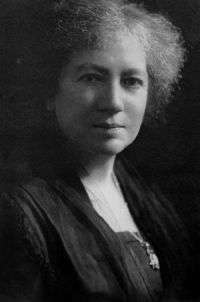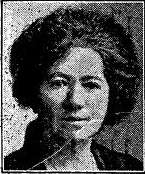Maria Gordon
Dame Maria Matilda Gordon DBE LLD (née Ogilvie; 30 April 1864 – 24 June 1939), known as May Ogilvie Gordon, was an eminent Scottish geologist, palaeontologist, and politician. She was the first woman to be awarded a Doctor of Science from University of London and the first woman to be awarded a PhD from the University of Munich[2]. She was also a supporter and campaigner for the rights and equality of children and women.
Dame May Ogilvie Gordon | |
|---|---|
 Dame May Gordon | |
| Born | Maria Matilda Ogilvie 13 April 1864 Monymusk, Aberdeenshire, Scotland |
| Died | 24 June 1939 (aged 75) Regent's Park, London |
| Resting place | Allenvale Cemetery, Aberdeen, Scotland[1] |
| Nationality | Scottish |
| Citizenship | British |
| Alma mater | Heriot Watt College, University College, London, University of Munich |
| Spouse(s) | Dr John Gordon ( m. 1895–1919) |
| Children | 3 |
| Awards | Lyell Medal (1932) DBE (1935) Honorary LLD from University of Edinburgh (1935) |
| Scientific career | |
| Fields | Geology |
| Thesis | (1900) |
Early life and education
Ogilvie was born in Monymusk, Aberdeenshire in 1864, the eldest daughter of Maria Matilda Nichol and Reverend Alexander Ogilvie, LL.D., headmaster of Robert Gordons College.[3][4] She had five brothers and two sisters. Her eldest brother, Francis Grant Ogilvie, was also a scientist and director of the London Science Museum.[3]
At the age of nine she went to the Merchant Company Edinburgh Ladies' College where she remained for nine years, becoming both head girl and the best academic pupil. At the age of 18 she went to the Royal Academy of Music in London where she studied piano. However, she left within a year to start a Bachelor of Science at Heriot-Watt College. She completed her degree, specialising in geology, botany and zoology, in 1890 at University College London.[3][4]
In 1891, she traveled to Germany to continue her studies at Berlin University. She was refused admission as women were not admitted to higher education institutions at the time in Germany, this despite the efforts of several influential friends and colleagues, including geologist Baron Ferdinand von Richthofen[3] She accompanied von Richthofen and his wife to Munich where she studied with Karl von Zittel and Richard von Hertwig and carried out research. In July 1891, the Richthofens travelled to the Dolomites for five weeks, inviting Ogilvie to go with them.[3]
It was in the Dolomites with Richthofen that she began to focus her work on geology.[3] In 1893 she was awarded the Doctor of Science in Geology from the University of London and was the first woman to receive this degree. In 1900, she and Agnes Kelly became the first women[5] to be awarded a PhD from the University of Munich, receiving a distinction in the fields of geology, palaeontology and zoology.[6]
Research
All of Maria Gordon's geological research was carried out in the South Tyrol, an area of the Italian Alps close to the border with Austria. This area of the Alps is part of the geologically-complex Dolomites. The Dolomites are a very distinct range of mountains, characterised by high, dramatic peaks, which were thought to have been formed from the remains of coral atolls in an ancient sea. Gordon challenged this idea with her theory of 'crust-torsion', the notion that the mountains had been formed by the pushing, twisting and folding of the earth's crust. Through observation and measurement of the geological structures in the Dolomites, she was able to determine that there were two phases of folding and structural deformation, leading to a new interpretation of the tectonic structure of the Alps.[7]
In total, she wrote more than 30 papers based on her research and findings in this region, some of which are considered seminal works.[8] Her biographer described her as "probably the most productive woman field geologist of any country in the late 19th and early 20th centuries."[9]
Politics

She was active in politics as a Liberal and an advocate of Women's Rights. On 8 February 1922 she was selected as prospective parliamentary candidate for the Lloyd George supporting National Liberals at the Canterbury constituency.[10] A General Election was called for November 1922 but on 3 November, she withdrew. Following Liberal re-union between Lloyd George and H. H. Asquith she contested the 1923 General Election as Liberal candidate for the Unionist seat of Hastings, pushing the Labour candidate into third place;
| Party | Candidate | Votes | % | ± | |
|---|---|---|---|---|---|
| Unionist | Lord Eustace Sutherland Campbell Percy | 11,914 | 52.6 | ||
| Liberal | Mrs Maria Matilda Ogilvie Gordon | 5,876 | 25.9 | n/a | |
| Labour | W. Richard Davies | 4,859 | 21.5 | ||
| Majority | 6,038 | 26.7 | |||
| Turnout | 76.4 | ||||
| Unionist hold | Swing | ||||
As an advocate of women's rights, she served as Vice President of the International Council of Women, Honorary President of the Associated Women's Friendly Society and the National Women's Citizens Association, and also as President of the National Council of Women of Great Britain and Ireland.[12] She played an important part in the post-World War 1 negotiations at the Council for the Representation of Women in the League of Nations.[13]
In 2000 to commemorate her contributions to palaeontology, a new fossilised fern genus Gordonopteris Iorigae was named after her. It was discovered in the Triassic sediments of the Dolomites.[14]
A room at the Ludwig Maximilian University of Munich's library, the Maria-Ogilvie-Gordon-Raum, is named in her honour. It houses the map collection of the department of geology.[15]
References
| Wikimedia Commons has media related to Maria Gordon. |
- "Dame Maria Ogilvie Gordon, 1864–1939". Retrieved 7 December 2013.
- Wachtler, M. and Burek, C.V. 2007. Maria Matilda Ogilvie Gordon (1864–1939): a Scottish researcher in the Alps. Geological Society, London, Special Publications, 281(1), pp.305-317.
- Burek, Cynthia V.; Higgs, Bettie (2007). The role of women in the history of geology. Geological Society of London. pp. 305–318. doi:10.1144/SP281.20.0305. ISBN 1-86239-227-7.
- Hartley, Cathy (2003). A historical dictionary of British women. Routledge. pp. 188–89. ISBN 1-85743-228-2.
- Herklots, John (2015). "Agnes Murgoci (1875-1929)" (PDF). Ryde Social Heritage Group.
- "Women Scientists". National Library of Scotland. Retrieved 4 March 2015.
- Ogilvie Gordon, M. M. 1927. Das Grödener, Fassa und Ennerberggebiet in den Südtiroler Dolomiten, Geologische Beschreibung mit besonderer Berücksichtigung der Ueberschiebungscheinungen. Abhandlungen der Geologischen Bundesanstalt Wien, Vol. 24, fasc. 1&2.
- "Scottish Women Scientists". National Library of Scotland. Retrieved 4 March 2015.
- "Dame Maria Ogilvie Gordon". Scottish Geology. Retrieved 4 March 2015.
- Aberdeen Journal, 9 February 1922
- FWS Craig, British Parliamentary Election Results 1918–1949; Political Reference Publications, Glasgow 1949
- "Dame Ogilvie Gordon Obituary". The East Anglian Daily Times. 26 June 1939. p. 14.
- "Women. A Modern Political Dictionary". Retrieved 4 March 2015.
- Bressan, David (14 June 2011). "A women geoscientist in the Dolomites: Maria Matilda Ogilvie Gordon". historyofgeology.fieldofscience.com. Retrieved 8 December 2013.
- "Kartensammlung am Lehrstuhl für Geologie - Lehrstuhl für Geologie - LMU München". www.geologie.geowissenschaften.uni-muenchen.de.
| Non-profit organization positions | ||
|---|---|---|
| Preceded by Laura Ridding |
President of the National Union of Women Workers 1916–1920 |
Succeeded by Maud Palmer, Countess of Selborne |